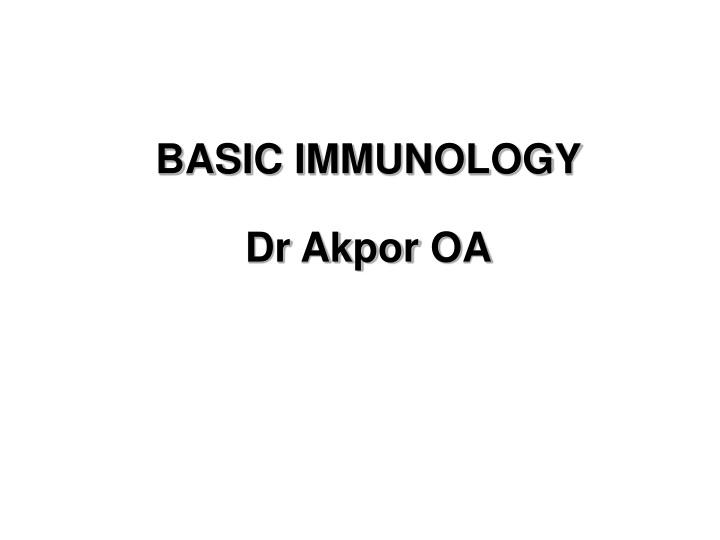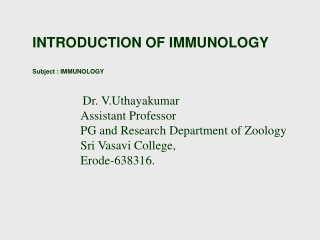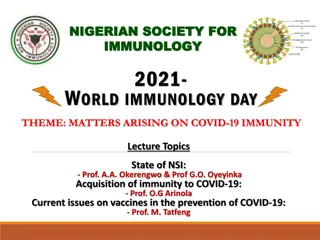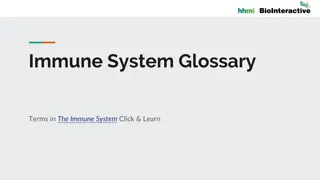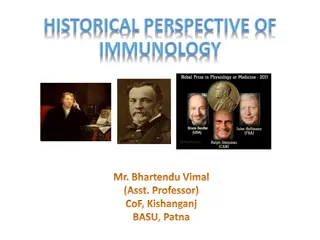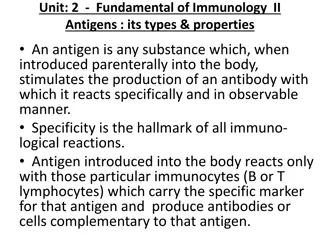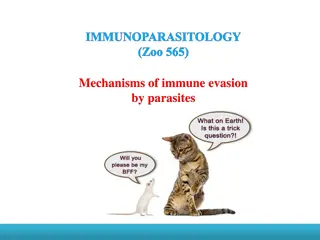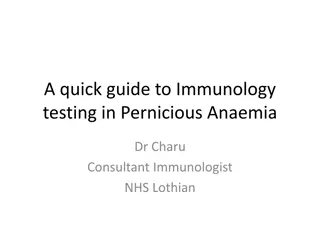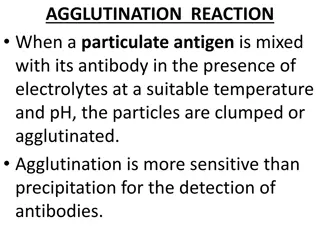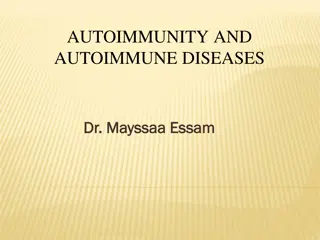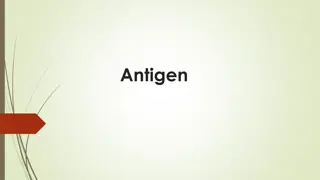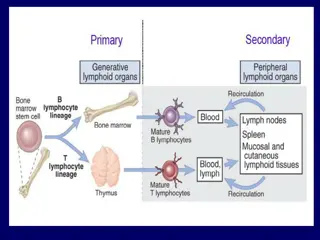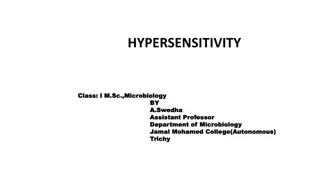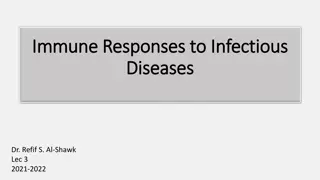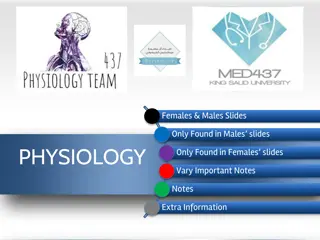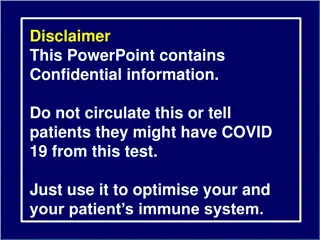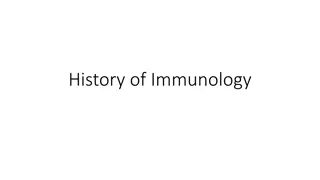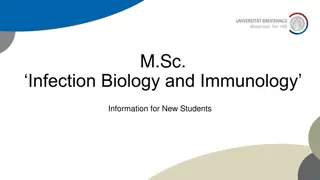Basic Immunology by Dr. Akpor: Understanding the Immune System
In this lecture by Dr. Akpor, students will delve into the role of the immune system, types of immunity, antibodies, and immunodeficiency. Dive into the definitions, organs, cells, and molecules involved in the immune response. Explore the defense mechanisms against microbes, tumor cells, and diseased cells for a holistic understanding of immunology.
Download Presentation

Please find below an Image/Link to download the presentation.
The content on the website is provided AS IS for your information and personal use only. It may not be sold, licensed, or shared on other websites without obtaining consent from the author.If you encounter any issues during the download, it is possible that the publisher has removed the file from their server.
You are allowed to download the files provided on this website for personal or commercial use, subject to the condition that they are used lawfully. All files are the property of their respective owners.
The content on the website is provided AS IS for your information and personal use only. It may not be sold, licensed, or shared on other websites without obtaining consent from the author.
E N D
Presentation Transcript
BASIC IMMUNOLOGY Dr Akpor OA
OBJECTIVES At the end of the lecture, students will be able to: Explain the role of the immune system Describe the two types of immunity Explain antibodies and its various types Define immunodeficiency
DEFINITIONS Immune system: cells, tissues, and molecules that mediate resistance to infections Immunology: study of structure and function of the immune system Immunity: resistance of a host to pathogens and their toxic effects Immune response: collective and coordinated response to the introduction of foreign substances in an individual mediated by the cells and molecules of the immune system
ROLE OF THE IMMUNE SYSTEM Defense against microbes Defense against the growth of tumor cells kills the growth of tumor cells Homeostasis destruction of abnormal or dead cells (e.g. dead red or white blood cells, antigen-antibody complex)
IMMUNE SYSTEM 1. Organs 2. Cells 3. Molecules
Immune System: (1) organs Tonsils and adenoids Thymus Lymph nodes Spleen Lymphiod tissue Appendix Lymphatic vessels Bone marrow
IMMUNE SYSTEM: (2) CELLS Lymphocytes T-lymphocytes B-Lymphocytes, plasma cells natural killer cells Monocytes, Macrophage Granulocytes neutrophils eosinophils basophils
IMMUNE SYSTEM: (3) MOLECULES Antibodies Complement proteins Cytokines Interleukines Interferons TNF
TWO TYPES OF IMMUNITY 1. Innate (non-adaptive) first line of immune response relies on mechanisms that exist before infection 2. Acquired (adaptive) Second line of response (if innate fails) relies on mechanisms that adapt after infection handled by T and B lymphocytes one cell determines one antigenic determinant
INNATE IMMUNITY Based on genetic make-up Relies on already formed components Rapid response: within minutes of infection Not specific same molecules / cells respond to a range of pathogens Has no memory same response after repeated exposure
Innate immunity: mechanisms Mechanical barriers / surface secretion skin, acidic pH in stomach, cilia Humoral mechanisms lysozymes, basic proteins, complement proteins, interferons, TNF Cellular defense mechanisms natural killer cells neutrophils, macrophages, mast cells, basophils, eosinophils
Adaptive immunity: second line of response Based upon resistance acquired during life Relies on genetic events and cellular growth Responds more slowly, over few days Is specific each cell responds to a single epitope on an antigen Has anamnestic memory repeated exposure leads to faster, stronger response
Adaptive Immunity: active and passive
Adaptive immunity: mechanisms Cell-mediated immune response (CMIR) T-lymphocytes eliminate intracellular microbes that survive within phagocytes or other infected cells Humoral immune response (HIR) B-lymphocytes mediated by antibodies eliminate extra-cellular microbes and their toxins Plasma cell (Derived from B-lymphocyte, produces antibodies)
TYPES OF ADAPTIVE IMMUNITY Natural acquiredactive immunity; resulting from infection naturally this type of immunity may be long-lasting. Natural acquiredpassive immunity Antibodies transferred from a mother to a fetus (trans placental transfer) or to a newborn in colostrum results in naturally in the newborn; can last up to a few months. Artificially acquired active immunity Immunity resulting from vaccination can be long-lasting. Artificially acquired passive immunity refers to humoral antibodies acquired by injection; can last for a few weeks.
Cell-mediated immune response T-cell recognizes peptide antigen on macrophage in association with major histo-compatibility complex (MHC) class Identifies molecules on cell surfaces Helps body distinguish self from non-self T-cell goes into effectors cells stage that is able to kill infected cells
T lymphocytes 2 types Helper T- lymphocytes (CD4+) CD4+ T cells activate phagocytes to kill microbes Cytolytic T-lymphocyte (CD8+) CD8+ T cells destroy infected cells containing microbes or microbial proteins
Cell mediated immune response Primary response production of specific clones of effector T cells and memory clones develops in several days does not limit the infection Secondary response more pronounced, faster more effective at limiting the infection Example - cytotoxic reactions against intracellular parasites, delayed hypersensitivity (e.g., Tuberculin test) and allograft rejection
Humoralimmune response 1. B lymphocytes recognize specific antigens proliferate and differentiate into antibody-secreting plasma cells 2. Antibodies bind to specific antigens on microbes; destroy microbes via specific mechanisms 3. Some B lymphocytes evolve into the resting state - memory cells
Antibodies (immunoglobulins) Belong to the gamma-globulin fraction of serum proteins Y-shaped or T-shaped polypeptides 2 identical heavy chains 2 identical light chains Five kinds of antibodies IgG, IgM, IgA, IgD, IgE (GMADE)
IgG 70-75% of total immuniglobulin Secreted in high quantities in secondary exposures Cross the placenta Neutralize microbes and toxins Opsonize antigens for phagocytosis Activate the complement proteins Protect the new-born
IgM Secreted initially during primary infection Cannot cross the placenta Secreted first during primary exposure Used as a marker of recent infection Presence in new-born means infection Single positive sample in serum or CSF indicates recent or active infection Used to detect early phase of infection
IgA Dimeric ( a molecule composed of two identical, simpler molecules) with secretory component in the lumen of the gastro- intestinal tract and in the respiratory tract Neutralizes microbes and toxins Sero-diagnosis of tuberculosis Synthicial respiratory virus tests
IgD Monomeric Present on the surface of B lymphocytes Functions as membrane receptor Role unclear Has a role in antigen stimulated lymphocyte differentiation
IgE Monomeric Associated with anaphylaxis Plays a role in immunity to helmintic parasites Sero-diagnosis of infectious and non infectious allergies (e.g., allergic bronchopulmonary aspergillosis, parasitic diseases)
Failure of immune response Immune response helps individuals defend against: microbes Some cancers Immune response can fail Hypersensitivity reactions Immunodeficiency
Hypersensitivity reactions Cause cell damage through excessive immune response to antigens Hypersensitivity Overreaction to infectious agents Allergy Overreaction to environmental substances Autoimmunity Overreaction to self
Immunodeficiency Loss or inadequate function of various components of the immune system Can occur in any part or state of the immune system physical barrier, phagocytes, B lymphocytes, T lymphocytes, complement, natural killer cells The immuno-compromised host has an impaired function of immune system is at high risk of infection
Immunodeficiency Congenital (primary) immunodeficiency genetic abnormality defect in lymphocyte maturation Acquired (secondary) immunodeficiency results from infections, nutritional deficiencies or treatments e.g AIDS, chronic leukemia
Summary (1) Innate immunity Relies on mechanisms already existing before microbe infects host Is the first line of defence Has no memory for subsequent exposure Relies on non specific mechanisms
Summary (2) Adaptive immunity Develops following entry of microbe into the host Comes into action after innate immunity fails to get rid of microbe Has memory to deal with subsequent exposure Happens through specific cells T cells (cell mediated) B cells (antibody mediated)
Summary (3) Primary immune response Short lasting Smaller in magnitude Secondary immune response Longer in duration Larger in magnitude Develop memory cells following primary response Failure of immune response can result in: Hypersensitivity Immunodeficiency
